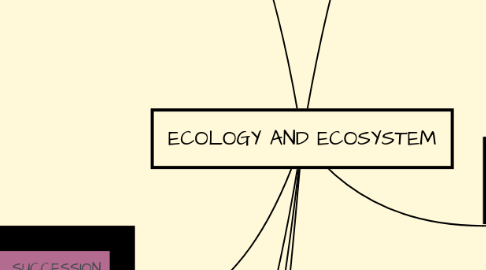
1. ECOLOGIST
1.1. who study ecosystem identify the living organism as part of a population , community
1.1.1. population
1.1.1.1. all organism that same species in given area who can breed with another
1.1.2. community
1.1.2.1. all population living in an area
2. ECOSYSTEM DYNAMIC
2.1. Energy and Nutrient in the Ecosystem
2.1.1. energy
2.1.1.1. ability to do work
2.1.1.2. passed organism by feeding relationship in the ecosytem
2.1.1.2.1. TROPHIC LEVEL
3. THE FLOW OF ENERGY
3.1. FOOD CHAIN
3.1.1. feeding relationship between different living things
3.1.2. show the energy pass
3.1.3. if food chain overlap it become food web
3.1.3.1. food web
3.1.3.1.1. feeding relation among species in an ecological communty
3.1.3.1.2. specify energy relation and transfer amongst them
4. ECOLOGICAL SUCCESSION
4.1. observed process of change in the species structure of an ecological community over time
4.2. occurs when the conditions of an environment suddenly and drastically change
5. BIODIVERSITY
5.1. DEFINITION - variety and different among living organisms from all sources
5.2. TYPES OF BIODIVERSITY
5.2.1. community and system diversity
5.2.1.1. different habitat, niches and species interacton
5.2.1.2. perspectives
5.2.1.2.1. alpha (within community diversity)
5.2.1.2.2. beta (between community diversity)
5.2.1.2.3. gamma (diversity of the habitat of the total landscape)
5.2.2. species diversity
5.2.2.1. different kinds of organisms, relationship among species.
5.2.2.2. variety of species in a region
5.2.2.3. number of species in an area
5.2.3. genetic diversity
5.2.3.1. different genes and combination of genes within population
5.2.3.2. total number of genetic characteristic in a genetic
5.3. VALUES
5.3.1. food
5.3.2. drugs and medicine
5.3.3. fuel
5.3.4. social values
5.4. CONSERVATION OF BIODIVERSITY
5.4.1. DEFINITION - management of human use of the biosphere so that it may yield the greatest sustainable
5.4.2. basic approach
5.4.2.1. IN-SITU (conservation of species in its natural ecosystem
5.4.2.2. EX-SITU (conservation of component of biological diversity and involves maintenance and breeding
5.4.3. goal
5.4.3.1. protect entire ecosystem
5.4.3.2. species are preserved
5.4.4. challenge
5.4.4.1. people
5.4.4.2. regulation not informed by solid research
5.5. IMPORTANCES
5.5.1. generation of soils
5.5.2. maintenance of soil quality
5.5.3. pest control
5.5.4. pollunation
6. ECOLOGY
6.1. how all things in an ecosystem interact
7. ECOSYSTEM
7.1. small ecological units (all living things and non-living things in an area
7.1.1. non-living physical features
7.1.1.1. ABIOTIC FACTOR
7.1.2. living organism
7.1.2.1. BIOTIC FACTOR
7.2. TYPE OF ECOSYSTEM
7.2.1. FOREST ECOSYSTEM
7.2.1.1. terrestrial unit of living organisms
7.2.1.2. all interacting among themselves and with the environment in which they live
7.2.1.3. TYPES OF FOREST ECOLOGICAL
7.2.1.3.1. Tropical rain forest Tropical seasonal forest Temperate evergreen and deciduous forest Boreal forest Savanna and woodland
7.2.2. GRASSLAND ECOSYSTEM
7.2.2.1. biological community that contains few trees or shrubs, dominated by grasses or grass like plants
7.2.2.2. 19% of earth's surface
7.2.2.3. TYPES OF GRASSLAND ECOSYSTEM
7.2.2.3.1. Tropical and subtropical grasslands Temperate grasslands Flooded grasslands Montane grasslands Tundra grasslands Desert and xeric grasslands
7.2.3. DESSERT ECOSYSTEM
7.2.3.1. exists where there is little rainfall and the climate is extreme in harshness
7.2.3.2. 17% of the earth’s surface
7.2.3.3. TYPE OF DESSERT ECOSYSTEM
7.2.3.3.1. Hot and dry deserts Cold deserts Semi-arid deserts Coastal deserts
7.2.4. AQUATIC ECOSYSTEM
7.2.4.1. located in a water bodies
7.2.4.2. TYPE OF AQUATIC ECOSYSTEM
7.2.4.2.1. marine ecosystem
7.2.4.2.2. freshwater ecosystem
